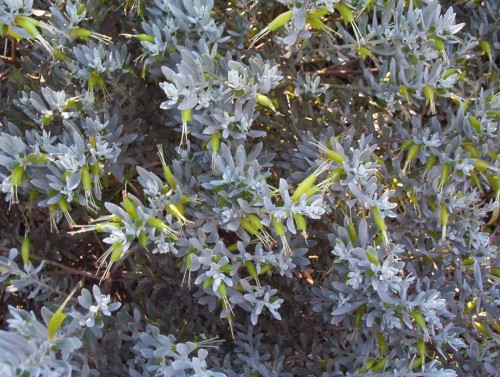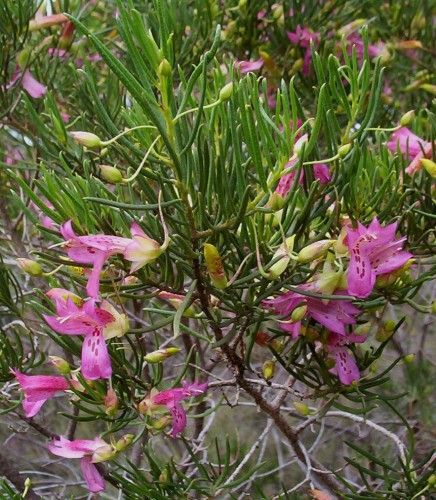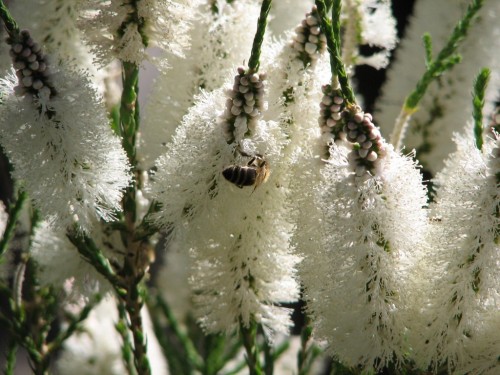Eremophila glabra ‘Brice’
Eremophila glabra ‘Brice’ is one of the most attractive Eremophilas. It has masses of lime green flowers on blue green foliage. The plants are abour 30cm tall by about 80 cm across. They do not appear to like acidic soil as I found out when my potting mix became too acid. The leaves took on a burnt appearance on the tips. When I watered the pots with water containing agricultural lime, the problem was gradually corrected.
There are a number of Eremophila glabra forms. All need good drainage and do best in full sun. They will grow quite well with part of the day in dappled shade.
Hardy Eremophilas
I was collecting cuttings of Eremophilas (Emu Bushes) today and realised I had quite a good collection of species, with lots still to collect. I read constantly that those folk who are in drought affected areas have found that Eremophilas are the plants that survive when others have just not coped with the lack of rain or inability to water with hoses. I have also discovered in the nursery, that the pots that are on the edge of the watering system do much better than those being more heavily watered.
Hardy is a relative word. These are hardy here in the dry mallee areas of South Australia. In general, Eremophilas need good drainage and a sunny warm position. Many prefer heavier soils as opposed to sand.
Here is a list of some of my hardy plants.
- Eremophila glabra sub species (ssp) carnosa
- Eremophila glabra ‘Roseworthy’
- Eremophila glabra prostrate form with grey leaves and red flowers.
- Eremophila glabra ‘Brice’
- Eremophila divaricata
- Eremophila densifolia
- Eremophila divaricata x polyclada
- Eremophila subteretifolia
- Eremophila nivea
- Eremophila maculata various colour forms
- Eremophila youngii
- Eremophila drummondii
- Eremophila veneta
- Eremophila weldii
Everlasting Daisy Seeds
I found this article on the ABC Web site. Rain is needed to germinate these lovely plants or a sprinkler if allowed. Many areas in Australia are in drought and extra water for sprinkling is not available.
Everlastings lasting all year round.
Thursday, 24 August 2006
Presenter: Sian Gard
The Midwest and wheatbelt is famous around Australia for the wildflower season. Carpets of colourful flowers usually cover the ground from August to October, but not this year. The drought has considerably reduced the number of wildflowers.
What if you could have wildflowers in your very own garden, all year round?
Rob and Jen Warburton of Kojonup have turned the idea of growing wildflowers where you live into a growing business of selling everlasting seeds. Rob says the business came about, almost by accident ” We had a fellow collecting native seeds on our property on 200 hundred acres of bush we’ve got and just as a bi-product he sort of said, heres a kilo of seed why don’t you see if you can grow these things commercially, there’s a bit of a market for it”
Do these beautiful flowers need much care and attention when it comes to popping them in the garden? Not according to Rob ” we get the seeds and throw them on the ground, like you should do, like it happens in nature”
But with the size of the seeds and the amount of flowers that could spring up, you would think that making the everlasting seeds profitable and viable would be a labour intensive chore.
” Eventually the everlastings came up and we thought how are we going to harvest them? Says Rob ” I sort of then worked out a way for mechanically harvesting them, so by the time I had harvested them and put them through several process of cleaning them, we came out with quite a clean product. We were able to sell that and that was about five years ago”
There are hundreds or maybe even thousands of different types of flowers in the world to plant in your garden, but according to Rob what makes the everlasting or paper daises stand out is its uniqueness.
” There a long flowering annual, they come in lots of different colours. We grow the pink and white variety and also the pink variety, which is a very dark red sort of pink colour with a yellow centre, and some of them have a black centre, which is quite stunning as well. They grow through the winter months and flower mostly through the spring ” but as Rob explains these flowers can bring delight all year round “they can be grown all year, we have grown them in patches in November and they have flowered throughout the summer”
The pretty but very simple everlasting is not only a flower that is found in the Midwest and wheatbelt and admired by tourists, it’s a flower, which according to Rob is gaining popularity in the celebration of an everlasting union, marriage.
” We’ve had people who have picked the flowers and dried them, they’ve used them as table displays, in the bouquets themselves and we know a girl just locally who is very keen, who’s having a wedding in December, to come out and pick some flowers and dry them for table arrangements”
Eremophila alternifolia (Narrow-leaf Fuchsia Bush)
I was thinking about drought tolerant plants while collecting cuttings and taking photos this morning. It’s amazing how hardy some plants are. There is not a drop of moisture in the subsoil after a very dry winter.
Some Eremophilas are flowering. They are the plants that will survive the driest conditions. They need to be pruned to prevent straggly growth, or the leaves being above your head while you look at bare woody branches. Some can be chopped back to the stump and will sprout prolifically. Many prefer quite heavy soil, so long as the drainage is good. Eremophila alternifolia is one of these. This one needs to be tip prune regularly to maintain a neat bush.
Melaleuca hueglii
I do like this species. Ivan Holiday has written excellent books on the identification of these and the books are readily available.
Melaleuca hueglii is one that does very well here in dry and alkaline soils. This is quite a large shrub but accepts quite severe cutting to bare wood. There is a form which has pink buds that open to white flowers. It is best to trim these after flowering.





